Adding Polynomials
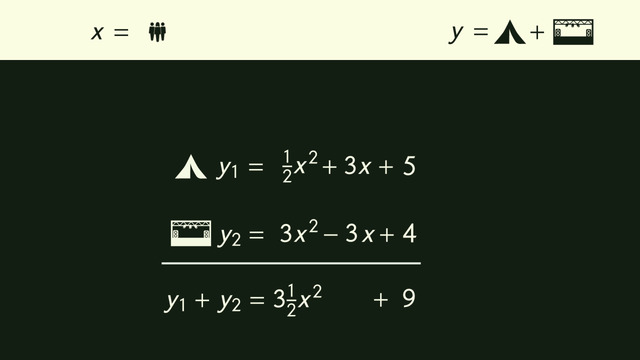

Basics on the topic Adding Polynomials
To work with polynomials, it’s important to know the lexicon, the language associated with polynomials: term, constant, monomial, binomial, trinomial, degree, like terms, and unlike terms. Polynomials are made up of terms. Terms can be variables alone, variables with exponents, and variables with coefficients with or without exponents. Terms can also be numbers which are called constants. Constants are really just numbers multiplied by xº (which is equal to one), but the variable and exponent are hidden - be aware that it exists.
A polynomial with one term is called a monomial; two terms is a binomial; three terms is a trinomial. More than that, we just call it a polynomial, so a polynomial with fifty terms is called a polynomial. How can you stay organized to do operations with polynomials? Before you can do an operation such as adding, put the terms in the standard form which is ordered by the degree of each term, from highest to lowest. The degree is determined by the exponent and for two or more variables in a term, the sum of the exponents.
Once polynomials are ordered in standard form, you can add the like terms. Like terms have the same variable and the same degree. Sometimes an unlike term can look the same as a like term, so be careful. To help you learn the language of polynomials and how to add the like terms of polynomials, press play so you can watch this video.
Perform arithmetic operations on polynomials.
CCSS.MATH.CONTENT.HSA.APR.A.1
Transcript Adding Polynomials
To hear long forgotten, but still glorious rock bands, Jack Rock is planning a music festival to be held near his hometown of Roc-n-roll. Jack needs to figure out how much space he’ll need for the festival. Like most musicians, he's a brilliant mathematician!
Polynomials and monomials
To calculate the amount of space he'll need, he adds polynomials. Polynomials are made up of terms. Terms can be variables with exponents, variables with coefficients, or constants. Polynomials with one term are called monomials. This polynomial, 2x² + 6x+ 5 , is made up of three monomials. We can also call this expression a trinomial because it has three monomials.
Polynomials are classified by degree, and the degree of a polynomial is determined by the highest exponent found in the polynomial. This visual aid will really help you understand, so take a look. For this term, 2x², the exponent is equal to 2 so the degree is 2. How do you count the degrees if there are two exponents in a term, you ask? Here we have the monomial 3x⁴y².
The degree of a term
To find the degree of a term with more than one variable, just add the exponents of the variables together: 4 + 2 = 6, so it has a degree of 6. What if there’s no exponent? There’s always an exponent, but you may not see it. Take 5x for example. 5x is the same as 5x¹, so it's a first degree polynomial.
Order the term in Standard Form
The constant, 3, has a hidden variable and a hidden exponent! ...it’s the same as 3x⁰, making it a zero degree mononomial. So what, you may be thinking. Who cares? Why do we need to know the degrees? Well, if you have several terms in a polynomial, it can get pretty hairy, so when we write polynomials, we use the Standard Form to order the terms from the highest degree to the lowest. It’s good to use the Standard Form to write polynomials because it makes the expression easier to read and calculate. Let's order these terms in Standard Form 3x⁴y² + 2x² + 5x + 3.
Back to Jack Rock. He's working very hard to figure out how much space he needs for the festival... So far, he's determined that every person attending the festival will need space for camping. He uses x to represent the unknown number of people and y₁ to represent the total amount of space needed for camping.
The expression is y₁ is equal to 5+3x+½ x². Plus, he knows it’s important to have enough space in front of the stage for people to see the show. .. So, using his mad math skills, he figures out the expression to calcualate this amount of space is y₂ is equal to 3x²+4-3x. Told you. He's a genius!
Calculate the total area
To calculate the total area, Jack adds the two polynomials together, but first he must put them in Standard Form. To start, he determines the degree of each term. He knows that 'x' without an exponent has a degree of 1, and constant terms have a degree of zero. Next he knows he should order the terms from the highest degree to the lowest. Notice how Jack has set up the two expressions vertically. Add the polynomials together by combining all like terms. What are like terms? Numbers with the same variable and the same degree. Let's see how he combines like terms...
A video image is worth a thousand words, how he combines the like terms. You can see how the 'X's cancel out..now add the last constants. There’s more than one way to go about combining these polynomials. The expression can also be set up horizontally. Use parentheses to help you stay organized.
Unlike terms
Again, Jack will combine like terms. Watch how the 'x' terms cancel out. As you can see, it’s the same sum as before. When you add polynomials, use the method that’s easiest for you. But, be careful and only combine like terms! Variables and exponent powers must be equal. Sometimes terms look similar, but they may have slightly different variables and exponents and cannot be combined. These are called unlike terms.
Whoo Hoo! Now Jack Rock can calculate the exact amount of space he needs for 'x' number of people. Look at the turnout! The concert sold out! It's time to party to the MAX!
Adding Polynomials exercise
-
Find out how much space the tents and the stage take up by adding the polynomials.
HintsTo get the standard form of a polynomial arrange the terms depending on their degree.
Start with the highest degree.
Here you have an example.
You can only combine like terms.
When adding or subtracting like terms, you have to add or subtract the coefficients.
$\begin{array}{rcr} 2x^2+5x^2-3x^2 &=& \\ (2+5-3)x^2 &=& \\ &=& 4x^2 \end{array}$
Solution$5+3x+\frac12x^2$ as well as $3x^2+4-3x$ are polynomials.
In this exercise, you were asked to add the polynomials horizontally. To do so, the first step is always rearranging the monomials in decreasing order of degree from left to right:
- $5+3x+\frac12x^2=\frac12x^2+3x+5$
- $3x^2+4-3x=3x^2-3x+4$
$\left(\frac12x^2+3x^2\right)+(3x-3x)+(5+4)$
Now we add or subtract the like terms by adding or subtracting the coefficients. We get:
$3\frac12x^2+9$
-
Add the polynomials vertically to find the combined space needed for tents and for the stage.
HintsWhen adding or subtracting like terms, you add or subtract the coefficients:
$7x+3x=(7+3)x=10x$
Like terms are like fruits: If you add $3$ apples and $2$ bananas, you will end up with $3$ apples and $2$ bananas, not $5$ app-nanas.
SolutionWhen adding polynomials, you first have to arrange the monomials in standard form in decreasing order of degree from left to right.
Next, write each monomial with like terms below each other. If you have terms in one polynomial where there is no matching term in the second polynomial, leave some space in the line of the second polynomial, and vice versa.
So when adding $\frac12 x^2+3x+5$ and $3x^2-3x+4$ vertically, you can write it like this:
$~~~~~\frac12 x^2+3x+5$
$~+3x^2-3x+4$
Next, you combine all like terms:
- $\frac12x^2+3x^2=\left(\frac12+3\right)x^2=3\frac12x^2$
- $3x-3x=(3-3)x=0x=0$
- $4+5=9$
$y_1+y_2=3\frac12x^2+0x+9=3\frac12x^2+9$
-
Identify the degrees of the given monomials.
HintsThe degree of a monomial doesn't depend on the coefficient.
The degree of $x^5$ is its exponent, $5$.
The degree of $7x^2y^4$ is $2+4=6$.
The degree of any constant is $0$.
The degree of $x$ is $1$.
SolutionEach monomial is assigned a degree depending on the exponent of its variable. If the monomial contains more than one variable, the exponents are added. The degree of any constant is $0$, whereas the degree of $x$ is $1$.
Here, you see the correct order for the given monomials.
- $x^3$ (degree: $3$), $4xy$ (degree: $1+1=2$), $5y$ (degree: $1$), $7$ (degree: $0$)
- $3x^3y^2$ (degree: $3+2=5$), $x^4$ (degree: $4$), $2xy^2$ (degree: $1+2=3$), $7x$ (degree: $1$)
- $2x^3$ (degree: $3$), $3x^2$ (degree: $2$), $x$ (degree: $1$), $2$ (degree: $0$)
-
Calculate the total space needed for the birthday party by adding the two polynomials.
HintsFill in the coefficients as well as the operation signs, $+$ or $-$.
First, write the polynomials in standard form.
$-3+5x^2+x \rightarrow 5x^2+x-3$
Remember to only combine like terms.
You can add like terms by adding the coefficients.
$2x^3-4x^3=(2-4)x^3=-2x^3$
SolutionWe have to add $y_1=2x-2+2x^2$ and $y_2=1+2x^2-4x$.
First, we arrange both polynomials in standard form according to the degrees of the monomials:
$\begin{array}{lccccccc} y_1=&2&x^2&+&2&x&-&2\\ y_2=&2&x^2&-&4&x&+&1\\ \hline &4&x^2&-&2&x&-&1 \end{array}$
In the last row, we add all like terms together by adding the coefficients.
-
Determine the degrees of the monomials.
HintsRemember that sometimes terms have hidden variables and/or exponents, like $x^0=1$ and $x^1=x$.
For each monomial with more than one variable, the exponents are added:
The degree of $12xy^3$ can be found by adding the exponents of $x$ and $y$: $1+3=4$.
SolutionThe degree of any polynomial is the highest degree monomial in the polynomial.
If we have a monomial with more than one variable, we add the exponents to determine its degree.
Remember, $x=x^1$ and $x^0=1$, so for example, $3x=3x^1$; therefore, its degree is $1$. Additionally, in $4=4x^0$, the degree is $0$.
So we have the following degrees:
- The monomial $2x^2$ has the degree $2$.
- The monomial $3x^4y^2$ has the degree $4+2=6$.
- The monomial $5x=5x^1$ has the degree $1$.
- The monomial $3=3x^0$ has the degree $0$.
-
Simplify the given polynomials by combining all like monomials.
HintsYou can only combine like terms.
For like terms, the variables and the exponents match.
Group like terms in sets of parentheses when adding horizontally or below each other when adding vertically.
SolutionIn math, you often have to simplify. This means you have to combine like terms.
Like terms contain the same variable as well as the same exponent.
For example, $x^3$ an $5x^3$ are like terms. You can add them together and get $6x^3$.
On the other hand, $3x^2$ and $2x^3$ aren't like terms, their variables match, but the exponents don't. $3x^2$ and $3y^2$ aren't like term either, their variables don't match.
$\begin{array}{rcl} ~\\ a^2x^2-2ax^2+3a^2x-5ax^2+2a^2x^2 &=&(a^2x^2+2a^2x^2)+3a^2x+(-2ax^2-5ax^2)\\ &=& 3a^2x^2+3a^2x-7ax^2\\ ~\\ \end{array}$
$\begin{array}{rcl} ~\\ ax^2-2ax+3a^2x^2-5a^2x+2ax^2 &= & 3a^2x^2-5a^2x+(ax^2+2ax^2)-2ax\\ &=&3a^2x^2-5a^2x+3ax^2-2ax\\ ~\\ \end{array}$
$\begin{array}{rcl} ~\\ ax-2a^2x+3ax^2-5a^2x^2+2a^2x &= &-5a^2x^2+(-2a^2x^2+2a^2x)+3ax^2+ax\\ &=&-5a^2x^2+3ax^2+ax\\ \end{array}$
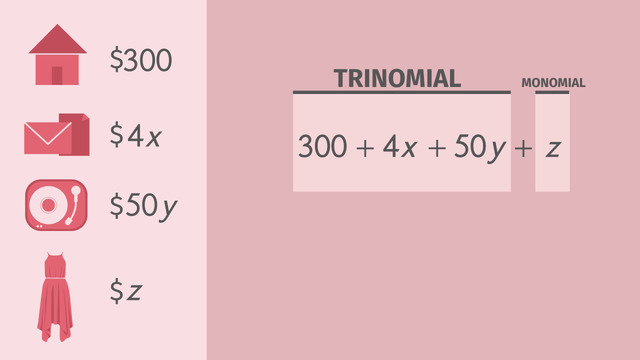
Introduction to Polynomials – Naming Polynomials by Number of Terms

Adding Polynomials

Multiplying Polynomials
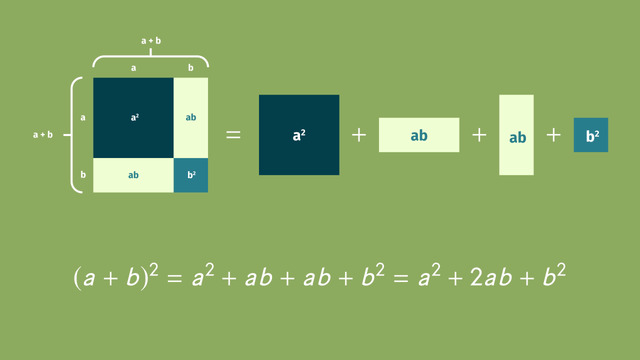
Multiplying Special Case Polynomials
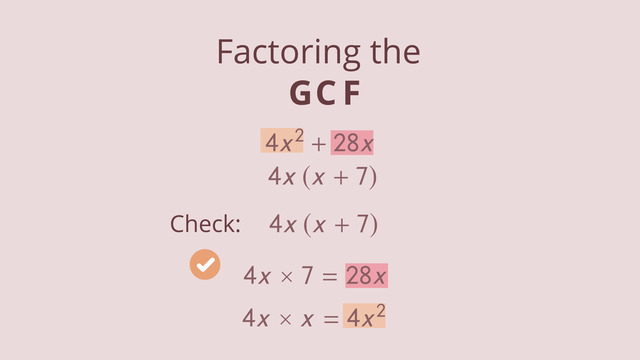
Factoring out the GCF
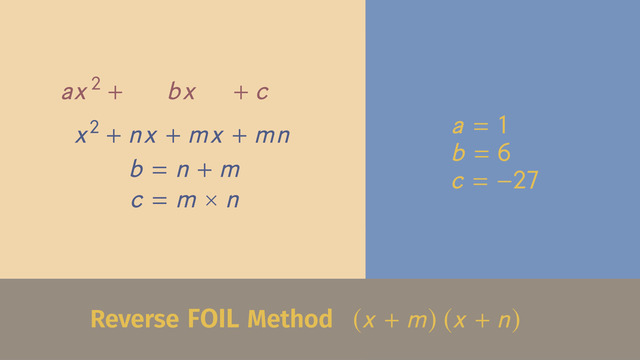
Factoring Trinomials with a = 1

Factoring Trinomials with a ≠ 1
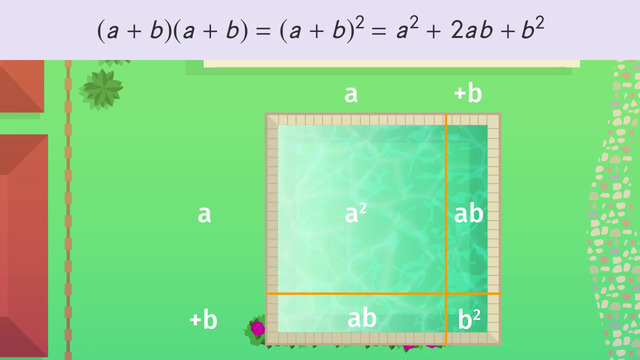
Factoring Special Case Polynomials
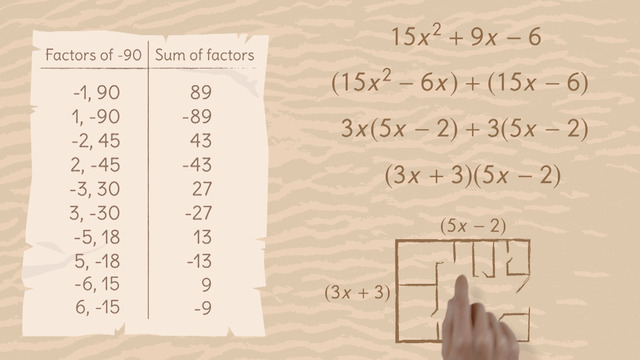
Factoring by Grouping
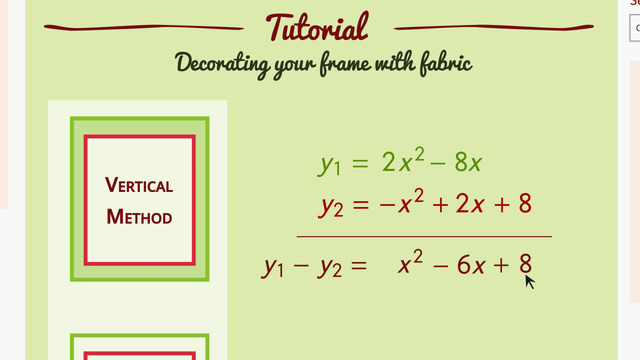
Subtracting Polynomials












Me too!
te amo!